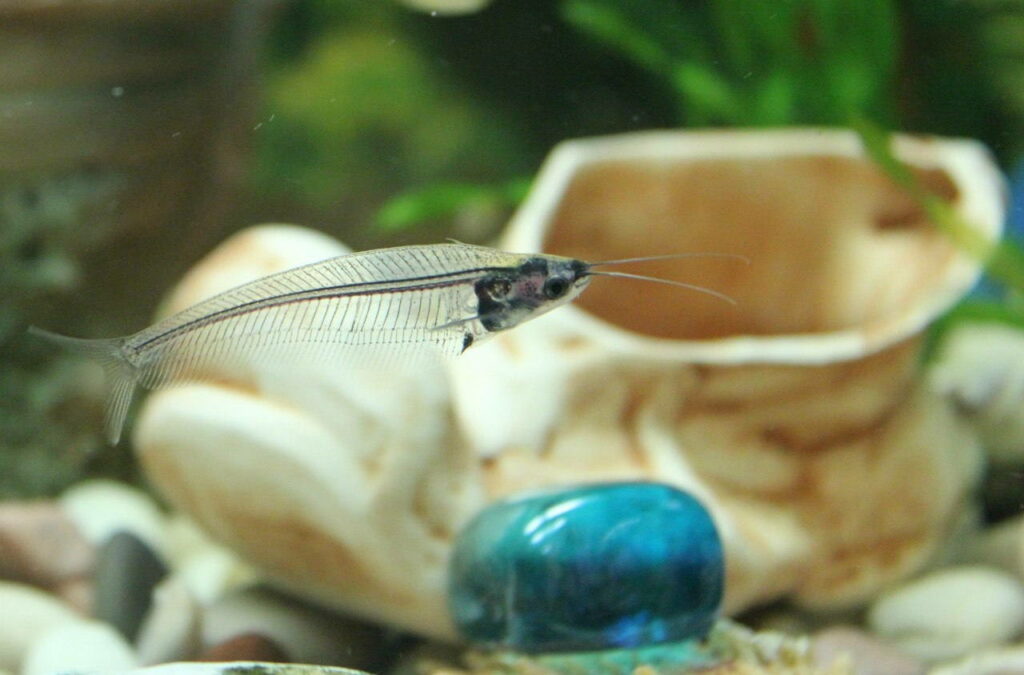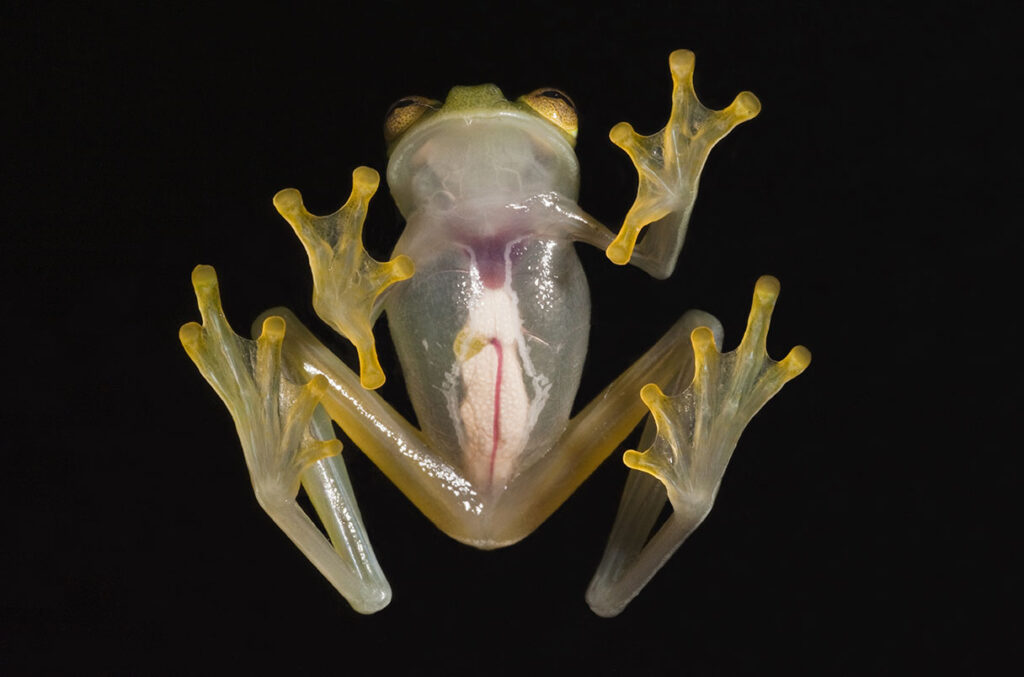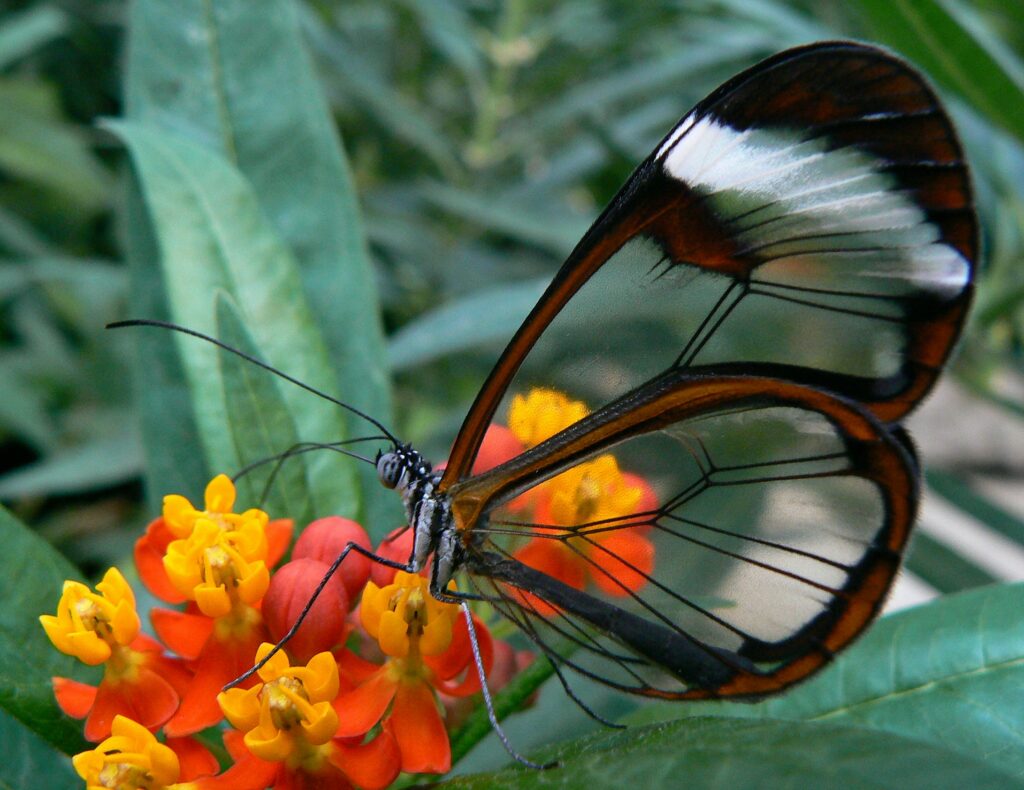The world is full of danger, and it would be very good if the bad guys could not see you. But how can you be invisible? Many animals have found a way to be transparent. We still don’t really know how that works.
Our most familiar experience with transparency is with glass. As most people know, glass is made from sand. But, whereas sand grains are separate, glass is a kind of liquid, a liquid that is very viscous and close to crystalizing, but not there yet. Technically, it is a super-cooled liquid. Old windows are thicker on the bottom than the top because the glass has been slowly descending in super-cooled liquid fashion. Liquids have no definite internal boundaries, and glass has no internal structure to show boundaries, which is one reason it is clear. This does not translate to animals that have muscles, nerves, and guts.

A transparent animal that is familiar in the pet trade is the glass catfish, Kryptopterus bicirrhis. The shallow streams and rivers in southeast Asia are this fish’s range, full of predators, and the glass cat does not want anyone to see it. All their guts are up next to the head, so there is the smallest area that is not transparent. The muscle in the long tail is mostly transparent (and we don’t know how they do that), hence the name “glass cat.” This fish is rather sensitive and is not a good choice for beginners. If you choose to keep them in your aquarium, consider that they are timid and comfortable only with others of their kind. They need high-quality water and prefer dim light with lots of plants around. They prefer not to be seen. Which is too bad because you bought them to see them.

By chance, two different research programs recently added substantially to our knowledge of how animals achieve transparency. Glass frogs live in trees in tropical America and are hard to see because they are greenish-transparent. We don’t know why their muscles are largely transparent, but their blood certainly is not. Red, like our own, the blood provides color to their otherwise clear tissues. But, when they are at rest, they hoard their blood in the liver, taking it out of the rest of the body, leaving no red traces to be seen in the limbs, where the muscles are transparent, just like the glass cat. By placing all colored parts together in the internal organs, they maximize the transparency of the rest of the body, being as invisible as they can be.

If muscles can be transparent, why not all organs? There is one set of organs that must have opaque elements. Although eyes have transparent membranes and lenses, these will only function in creating visual images if the sensory cells in the retina are isolated from each other with no light passing from one to another (how eye-ronic!) The light striking one receptor should not cross to others if we are to have a visual field of detail and acuity. Each visual sensor points to a particular region, and it must receive only the light from that region, or the eye would not form images with different colors and shapes. This means the eye must have dark, insulating membranes between sensory cells to work. Those dark membranes can never be transparent.
The paired eyes of very small marine animals are black dots that give away their location even when the rest of the body is transparent. Another recent report shows that to make the eyes invisible, two tricks are used. One is to line the outside of the dark membrane with reflective crystals (a kind of glass) such that instead of seeing the dark pigment of the eye, a predator may see a reflection of the ocean around it. Good trick! But, plankton go further. To make sure there is no sheen of reflection from their outer shell that gives away their body form, they have small bumps that interrupt the surface and provide scattered reflections that do not leave a clear outline of their body cuticle. It is a kind of camouflage that interrupts the body shape, just as hunters wear patterned clothing to hide their own body form, but it is done with reflection rather than color.

In a dangerous world full of predators, one group of prey animals holds a special place. The ithomiine butterflies of tropical America are sometimes called the “glass wing” butterflies. These remarkable butterflies can be abundant, even if little noticed, demonstrating their success. Ithomiine butterflies are toxic. They are butterflies no one should eat. They are transparent because they lack the profuse scales that make the color patterns on the wings of other butterflies. They present only the thin cuticle of the wing, which is clear in most insects. Some colored scales are present, mostly far away from the body. This is interesting because if a predator bites at these butterflies, it is likely to strike the wing well away from the body, and perhaps the butterfly will survive. If the predator sees well enough to eat the butterfly body, it will experience unpalatable and perhaps toxic reaction, learning never to bite that thing again. These butterflies are well-defended against attack by a predator that sees them for the first time. And they don’t want you to see them the first time, either.
